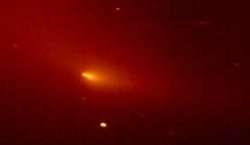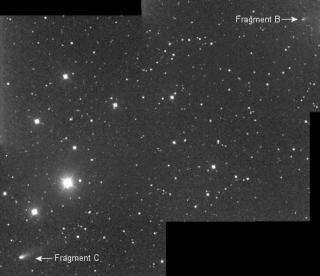Mini-Comets Approaching Earth

In 1995, Comet 73P/Schwassmann-Wachmann 3 did something unexpected: it fell apart. For no apparent reason, the comet's nucleus split into at least three "mini-comets" flying single file through space. Astronomers watched with interest, but the view was blurry even through large telescopes. "73P" was a hundred and fifty million miles away. We're about to get a much closer look.
In May 2006 the fragments are going to fly past Earth closer than any comet has come in almost eighty years.
"This is a rare opportunity to watch a comet in its death throes—from very close range," says Don Yeomans, head of NASA's Near Earth Object Program at JPL.

There's no danger of a collision. "Goodness, no," says Yeomans. "The closest fragment will be about six million miles away--or twenty-five times farther than the Moon." That's close without actually being scary.
The flyby is a big deal. "The Hubble Space Telescope will be watching," says Yeomans. "Also, the giant Arecibo radar in Puerto Rico will 'ping' the fragments to determine their shape and spin." Even backyard astronomers will be able to take pictures as the mini-comets file through the constellations Cygnus and Pegasus on May 12, 13 and 14.
Ironically these comets, so nearby, will not be very bright. The largest fragments are expected to glow like 3rd or 4th magnitude stars, only dimly visible to the unaided eye.
"Remember," says Yeomans, "these are mini-comets." They're not like the Great Comets Hayutake and Hale-Bopp of 1996 and 1997. Those could be seen with the naked eye from light-polluted cities. The fragments of 73P, on the other hand, are best viewed from the countryside--and don't forget your binoculars.
The number of fragments is constantly changing. When the breakup began in 1995 there were only three: A, B and C. Astronomers now count at least eight: big fragments B and C plus smaller fragments G, H, J, L, M and N. "It looks as though some of the fragments are themselves forming their own sub-fragments," says Yeomans, which means the number could multiply further as 73P approaches. No knows how long the "string of pearls" will be when it finally arrives.
Bonus: There could be a meteor shower, too.
This is very uncertain, indeed, forecasters consider it unlikely. But an expanding cloud of dust from the 1995 break-up of the comet could brush past Earth in May 2006 producing a display of meteors.
Astronomer Paul Wiegert at the University of Western Ontario has studied the possibility:
"We believe the cloud is expanding too slowly to reach Earth only eleven years after the break-up," he says, "but it all depends on what caused the comet to fly apart—and that we don't know."
"The most likely explanation is thermal stress, with the icy nucleus cracking like an ice cube dropped into hot soup: the comet broke apart as it approached the Sun after a long sojourn the frigid outer solar system," he explains. "If this is truly what happened, then the debris cloud should be expanding slowly, and there will be no strong meteor shower."
On the other hand, what if "the comet was shattered by a hit from a small interplanetary boulder?" A violent collision could produce faster-moving debris that would reach Earth in 2006.
Wiegert expects to see nothing, but he encourages sky watchers to be alert. It wouldn't be the first time a dying comet produced a meteor shower:
"One outstanding example is comet Biela, which was seen to split in 1846, and had completely broken apart by 1872," he says. "At least three very intense meteor showers (3000-15000 meteors per hour) were produced by this dying comet in 1872, 1885 and 1892."
Assuming a thermal breakup for 73P, Wiegert and colleagues have calculated the most likely trajectory of its dust cloud. Their results: dust should reach Earth in 2022, "producing a minor meteor shower--nothing spectacular. However," he adds, "the ongoing splitting of the comet means new meteoroids are being sent in new directions, so a future strong meteor shower from 73P remains a real possibility."
The watch begins on May 12th.
Sky maps: May 12, May 13, May 14.
Source: Science@NASA, by Dr. Tony Phillips















